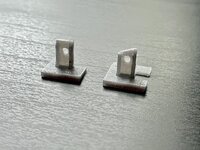I have a CD-ROM expansion module with a strange issue. It will only read discs if I hold the mechanism in place and press into the laptop. If I release, the disc spins down and unmount from the OS. Ejecting also only works if I release my hold on the door right as I hear the click of the latch releasing. Has anyone ever seen this before? Normally I hear stories about the drive doors falling off but this one is very secure, and the drive appears as it should from what I can tell. Here are some photos:



PowerBook 1400 Series CD-ROM Module Repair
- Thread starter Garrett
- Start date
You are using an out of date browser. It may not display this or other websites correctly.
You should upgrade or use an alternative browser.
You should upgrade or use an alternative browser.
I did some disassembly this evening and found the culprit. The latch responsible for closure and eject was cracked in half. I am going to try superglue as a first stab at it, but if that doesn't work I'll model something to 3D print. After the glue dries overnight, I'll post some results!


I've got two PB1400 CD-ROM drives this has happened to, and on my to-do list is designing some 3D-printable replacement brackets that can be glued to the original bezel. It's crazy (though not surprising, given the era) that Apple used such small/flimsy brackets, though I suppose the drive mechanism manufacturer is party to blame too.Normally I hear stories about the drive doors falling off
I'm wondering if Teac (who manufactured the drive) also designed that bezel, or if that was an Apple part which was mated to the 3rd party CD drive. I think a 3D printed reinforcement bracket seems like a very good option!
So far the superglue has worked to hold the eject latch together, but I'll be sure to update this thread if the repair doesn't last. At that point I'll have to either break out the JB Weld or the 3D printer.

So far the superglue has worked to hold the eject latch together, but I'll be sure to update this thread if the repair doesn't last. At that point I'll have to either break out the JB Weld or the 3D printer.
It would have been either Apple or Quanta who designed the bezel. The 1400 was an interesting machine in that the chassis was actually a "whitebox" design from Quanta. In order to get the machine to market faster (and bypass internal dysfunction), Apple basically gave the motherboard schematics for the 5300 to Quanta, picked that chassis from their catalog (because it supported an optical drive), and told them to build a PowerBook out of it. Apple's own internal design team apparently had *some* input into the final product, but I'm not clear on exactly how much -- either could have done the drive bezel. So if you've ever wondered why the 1400 always looked a little different from the rest of the PowerBook line from that era, it's because it could have easily been a Windows laptop instead!I'm wondering if Teac (who manufactured the drive) also designed that bezel, or if that was an Apple part which was mated to the 3rd party CD drive. I think a 3D printed reinforcement bracket seems like a very good option!
I've got two PB1400 CD-ROM drives this has happened to, and on my to-do list is designing some 3D-printable replacement brackets that can be glued to the original bezel. It's crazy (though not surprising, given the era) that Apple used such small/flimsy brackets, though I suppose the drive mechanism manufacturer is party to blame too.
I would absolutely love this. My 1400c's CD-ROM front bezel broke off years ago and is currently held in place by scotch tape... Definitely not ideal.
Guess could try welding with aceton/nail polish remover. Hard to tell what kind of plastic that is though.
I printed them with PLA, but you could use whatever material you prefer. I've had good luck gluing PLA parts using CA glue meant for plastics.
As promised, here's my video about replacement brackets for the 1400's CD-ROM drive bezel:
The .STL files are available here:
Thingiverse, https://www.thingiverse.com/thing:5176310
PrusaPrinters, https://www.prusaprinters.org/prints/106933-powerbook-1400-cd-rom-drive-bezel-brackets
The .STL files are available here:
Thingiverse, https://www.thingiverse.com/thing:5176310
PrusaPrinters, https://www.prusaprinters.org/prints/106933-powerbook-1400-cd-rom-drive-bezel-brackets

